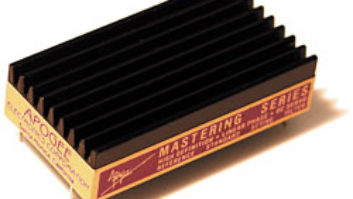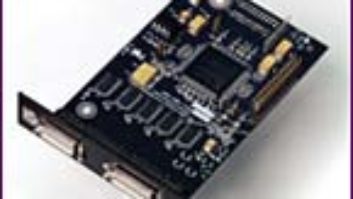Since its very beginnings, Apogee Electronics has been on the leading edge of pro audio. More recently, the company has become a premier supplier of outboard converters for discriminating users.
Apogee has included preamps in stereo A/D converter boxes for at least a decade, but with Trak2 — its latest offering — Apogee has delivered a world-class stereo preamp paired with an equally amazing 24-bit/96kHz ADC. Retailing at $3,995, Trak2 also includes a host of signal processing functions: Soft Limit™ overload protection, Soft Saturate™ analog tape compression effect, the Apogee low-jitter master clock, and Apogee’s industry-standard UV22HR™ bit reduction for retaining the punch of 24-bit signals when storing audio at 20 or 16 bits. Going a step further, Trak2 offers more I/O and routing options than some digital consoles on the market.
The front panel has a backlit LED menu display, simple cursor key/datawheel entry, LED status indicators, two ¼-inch/XLR Neutrik Combo aux inputs (line- or instrument level) that doubles as a hi-Z stereo direct box, a headphone output and 22-segment LED meters.
On the rear panel are two XLR mic “send” jacks that route the analog output from the preamp to external devices such as a tube limiter. Two XLR line inputs can either receive outputs from a console or act as returns from the preamp sends above. Also standard are wordclock/video sync I/O and a com port with a breakout cable for serial communications, and MIDI In/Out/Thru for remote control via a free Trak2 Remote Control application for Mac computers running OMS. In addition to the onboard AES-S/PDIF output, two Apogee Multimedia Bus (AMBus) slots accommodate a variety of cards for directly interfacing with Digidesign Pro Tools, Alesis ADAT, Tascam TDIF, SDIF-II, SSL HiWay and others. Another option is a 2- or 8-channel D/A card expansion slot, providing high-quality D/A conversion for mixing/monitoring from any source connected to the AMBus slot. Connectivity is not an issue here.
This is no ordinary preamp, and using the Trak2 requires a brief adjustment time. However, despite its menu-driven operation, navigating through the function pages is a straightforward process that can be mastered in minutes. Four cursor keys and a push-to-click datawheel take the user through various setup and operation menus. Navigation is easy, although some moves require a lot of button pushes. With this in mind, Apogee provides two Quick Keys for jumping to frequently used screens, and there are some hidden shortcuts (various presses of multiple cursor keys) that speed things along — assuming you can remember the shortcut. Fortunately, once you’ve set preamp parameters (gain/pad, phantom in/out, polarity reverse, HP filter, desired routing, DSP options, etc.), operation is mostly set-and-forget, and users can store frequently used settings in memory.
The built-in, high-output headphone amp is useful, and will especially be appreciated in location recording situations where you need to make sure everything’s flowing properly. Unfortunately, the only way to get to its volume is via the headphone menu, so rapid changes aren’t its forté, but on the plus side, pushing both Quick Keys takes you right to the headphone menu.
IN USE
Over a period of months, on all sorts of sessions, Trak2’s versatility and impeccable audio performance impressed me. The preamps are clean and transparent, with tons of headroom and a 90dB gain range that was an ideal match for my low-output Royer ribbon mics. The preamp’s response is uncolored, but if you want a little more personality, the Soft Saturate analog tape emulation adds smooth, warm compression without being overbearing. I really liked the Soft Saturate for laying bass guitar tracks to disk using the auto-input-sensing, front panel DI inputs. The Soft Limit feature does a great job of removing the worry from digital overloads, particularly when tracking unpredictable sources (like all the bands I work with), but it’s just amazing when creating huge, in-your-face pop or rock mixes.
Clearly, Trak2 is no lightweight — especially in terms of its 14-inch depth and massive heft. Even after extended periods, the unit runs fairly cool, thanks to massive heat sinks and a small internal fan, which is barely discernible in the quietest of control rooms. The meters are fast-acting and switchable to various ballistics, scales and peak hold options. They can also be selected to operate as phase meters, which is a great resource for tracking stereo sources or mixing. Nice!
Apogee is best known for its digital converters, and Trak2 does not disappoint. The 24-bit A/D (117dB dynamic range) converter can run at 44.1, 48, 88.2 and 96 kHz, while its noise floor is absolutely nonexistent. This, combined with its versatile routing to any of its digital outs, award-winning UV22HR processing, low-jitter clocking and high-performance preamp, makes this a studio powerhouse for the small or large facility.
Apogee Electronics, 3145 Donald Douglas Loop South, Santa Monica, CA 90405; 310/915-1000, fax 310/391-6262; www.apogeedigital.com.
SPEC SHEET: APOGEE TRAK2
Preamp
Gain/attenuation range:
-90 to +90 dB
Gain steps:
0.5/1/2/3/4 dB (user defined)
Inputs:
mic/line/instrument (switchable)
Phantom power:
+48VDC, auto sensing
Tweaks:
-20dB pad, phase 40/90Hz HPF
Sends:
balanced/unbalanced, +28dBu gain adjust
Returns:
balanced/unbalanced, +4 dBu or -10 dBV
Digital I/O
ADC Connections:
Built-in AES-S/PDIF out with two AMBus slots supporting multiple formats, including Pro Tools, ADAT, TDIF, SDIF-II, etc.
Sampling:
44.1/48/88.2/96 kHz
Output:
24-bit, with 16/20-bit support via UV22HR
Optional DAC:
2- or 8-channel 24-bit/96kHz
Crystal:
44.1 to 96 kHz
Wordclock I/O:
44.1 to 96 kHz
Internal Clock:
Apogee Ultra-Low Jitter circuit
General
Headphone amp:
40-watt
Video:
optional sync to NTSC, PAL and B&W video
Control:
MIDI In/Out/Thru and RS-232 serial
DSP:
Soft Limit, Soft Saturate, DC removal from digital inputs
Dimensions:
19×1.75×14 inches (W×H×D)



